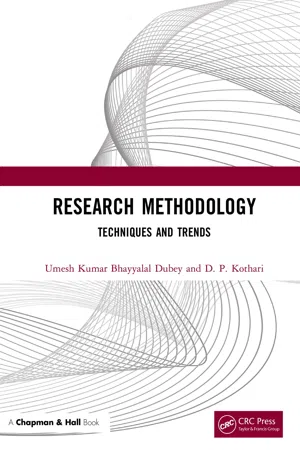Psychology
Quantitative and Qualitative Methods
Quantitative methods in psychology involve the use of numerical data and statistical analysis to measure and analyze behavior and mental processes. Qualitative methods, on the other hand, focus on understanding the meaning and context of human experiences through non-numeric data such as interviews, observations, and open-ended responses. Both approaches offer valuable insights and are often used in combination to provide a comprehensive understanding of psychological phenomena.
Written by Perlego with AI-assistance
Related key terms
10 Key excerpts on "Quantitative and Qualitative Methods"
- eBook - ePub
Mixing Methods in Psychology
The Integration of Qualitative and Quantitative Methods in Theory and Practice
- Zazie Todd, Brigitte Nerlich, Suzanne McKeown, David D. Clarke(Authors)
- 2004(Publication Date)
- Psychology Press(Publisher)
There have been few books that attempt to bridge the gulf between the newer qualitative methods and the older, but still dominant, quantitative methods used in psychology and the social sciences. In this volume, we explore some of the issues around the qualitative-quantitative divide in psychology, looking at both the theoretical and practical considerations of a mixed-method approach.Theoretical background: the split between Quantitative and Qualitative Methods in psychology
To study the human being in all its aspects, psychologists make use of a range of methods. However, since the inception of psychology as a “science” in the nineteenth century, quantitative methods have been the favourite choice. They have even become, as Danziger calls it in analogy to Kant’s categorical imperative, the “methodological imperative” (cf. Danziger, 1985). Since the end of the nineteenth century these methods have been increasingly refined by more and more complex types of statistics, and they have been adapted to computer technology.However, since the 1960s some psychologists, especially those dealing with social phenomena, have become dissatisfied and disillusioned with the products of this purely quantitative approach to human nature, and have opted for a more naturalistic, contextual and holistic understanding of human beings in society. The methods they favour have come to be known as qualitative methods. They range from ethnographic fieldwork, especially participant observation or direct social observation in the context of everyday life, to structured and unstructured interviews, surveys, documentary historical research, and most prominently in recent years, various types of discourse and conversation analysis, personal construct work, action research, grounded theory, and feminist methodology (cf. Banister et al., 1994:2). These methods focus on the interpretative (or hermeneutic) understanding of the meaning - eBook - ePub
- Thomas M. Heffernan(Author)
- 2005(Publication Date)
- Psychology Press(Publisher)
The reader is now introduced to the fundamentals of hypothesis/question formation, research methods, and associated analysis. Having a knowledge of research methods and analysis serves a number of functions: It enables you to assess the value of findings reported in various sources, such as newspapers, formal reports, magazines, etc. It enables you, as a researcher, to assess the value of existing lines of research (such as, for example, the longterm efficacy of a particular drug treatment). It provides the motivation for new research projects, which can be aimed at furthering our knowledge of relevant theory/research. The quantitative/qualitative distinction Social scientists in general, and psychologists in particular, make a distinction between quantitative and qualitative research. Quantitative research involves the collection of numerical data in order to answer questions about some phenomenon (for example, the use of questionnaires to estimate how many people use alcohol or other substances, or the administration of cognitive tests to estimate how well people remember under certain conditions, and so on). Statistics are applied to the data in order to summarise the findings and enable the researcher to draw inferences about the wider population from which the sample is drawn. Q ualitative research is best suited for situations where the phenomenon under study does not lend itself easily to quantitative methodologies (such as attempting to find out why a person uses addictive drugs, why people commit crime, and so on). In reality, many researchers combine both approaches. For example, a “qualitative” researcher may collect some data in order to bolster her or his argument; and a “quantitative” researcher may first ask a series of general questions in order to guide hypothesis formation, before going on to test these hypotheses using a quantitative methodology - eBook - ePub
- Matt Jarvis(Author)
- 2006(Publication Date)
- Routledge(Publisher)
meanings of data; that is, they interpret that when people say something that they are revealing something important. Some research methods such as experiments generate mostly quantitative data, whilst others such as interviewing are looking mainly for qualitative information. Of course, sometimes we can extract some interesting numbers from interviews (e.g. the percentage of people answering a particular way), and sometimes some of the most interesting findings from experiments are not so much the numbers we obtain but observations of comments participants make about the procedure.Some psychologists have very strong feelings about the usefulness of qualitative and quantitative research. Some qualitative researchers believe that quantitative methods are clumsy and miss uncovering the most important details available from research. On the other hand, some quantitative researchers see qualitative methods as informal and lacking in scientific rigour. A simple and pragmatic way of thinking about the qualitative–quantitative debate is that we need both approaches because they tell us different things. When we want to know whether two variables, say, extraversion and success as a track athlete, are related, or whether there is a difference in the numbers of goals scored in home and away games, we are clearly dealing with variables that can be measured numerically. In these cases, there is no doubt that quantitative data should be gathered. However, if we are using a focus group method to find out about people’s motives for taking up sport, we will soon find that if all we analyse is the frequency with which people identify a particular reason, we will begin to ignore some of the most important things our participants are telling us. In this case, we would do well to concentrate on collecting qualitative data. The vast bulk of sport psychology research collects quantitative data, and so most space in this chapter is devoted to quantitative methods. - eBook - ePub
- David Giles(Author)
- 2013(Publication Date)
- Routledge(Publisher)
Part IV Qualitative MethodsPassage contains an image
11 Qualitative Research in Psychology
DOI: 10.4324/9780203759851-15The aim of this part of the book is to give the reader some idea of the important techniques in qualitative research that are regularly used in psychology. The use of qualitative methods in psychology has increased significantly in recent years, and yet to many psychologists, qualitative research is an area of deepest mystery. To others it may even be a source of contempt. Even qualitative researchers themselves argue fiercely about the methods they use, and some prefer not to use the term ‘methods’ at all (Parker 1992 ). So complex are the issues around qualitative research that it has become a broad research topic in its own right, with social scientists from various disciplines specialising in the field (Denzin and Lincoln 2000 is a mighty volume gathering together a vast range of writing on the topic).Given the scope of qualitative research, it might seem surprising that so many psychologists should be ignorant of the area or hostile to its methods, especially since quantitative approaches to psychology have been criticised for a long time.1 However, there are several reasons why psychology has been reluctant to embrace qualitative methods over the years. To begin with, psychology has spent much of its short history fighting for scientific status. In order to stave off criticism from the established scientific disciplines, it has tended to be rather conservative in its preferred methods, valuing experimentation above other paradigms (especially during the behaviourist era), and insisting on measurement as the only way of meeting the criteria for scientific validity.This has led to what Danziger (1990) has termed ‘methodolatry’, whereby techniques such as single case studies, commonly used in long-established sciences, have been dismissed as unscientific. It sometimes seems as though what passes for science is what looks most like science, so structural equation modelling is worshipped by academic journal editors and reviewers, while other, less ostentatious methods are sneered at. How psychologists ‘do science’ is far from being a quantitative vs. qualitative debate; as we shall see in Chapter 21 - eBook - ePub
- Thomas M Heffernan(Author)
- 2015(Publication Date)
- Psychology Press(Publisher)
4 A guide to research methods DOI: 10.4324/9781315849430-4This chapter introduces the reader to research methods in psychology.Since psychology is ultimately about the scientific study of behaviour, it is necessary to consider what methodological tools are used in order to gain a fuller understanding of that behaviour. These different methods of investigation should be seen in terms of each one serving a particular purpose, rather than in terms of one method being “bett er” or “worse” than another. Eysenck (2009) likens it to a golfer selecting a particular golf club for a particular type of shot: it is simply a matt er of selecting the one that is best designed for that purpose, not because one club is “bett er” than the other.On a Bachelor of Science (BSc) psychology degree course (as well as on many other types of psychology course), research methods, and associated analysis, comprise a large component of the course, culminating, on most degree courses, in a large-scale, final-year research project. The rest of this section is taken up with introducing the reader to the fundamentals of hypothesis/question formation, research methods, and associated analysis. Having a knowledge of research methods and analysis serves a number of functions:- It enables you to assess the value of findings reported in various sources, such as newspapers, formal reports, magazines, etc.
- It enables you, as a researcher, to assess the value of existing lines of research (such as, for example, the long-term efficacy of a particular drug treatment).
- It provides the motivation for new research projects, which can be aimed at furthering our knowledge of relevant theory/research.
The quantitative/qualitative distinction
Social scientists in general and psychologists in particular make a distinction between quantitative and qualitative - John McLeod(Author)
- 2013(Publication Date)
- SAGE Publications Ltd(Publisher)
not: that is, it is research that does not involve the use of measurement or statistical techniques. For example, Miles and Huberman (1994) describe qualitative data as ‘words rather than numbers’, while Strauss and Corbin (1998) view the qualitative approach as comprising ‘any kind of research that produces findings not arrived at by means of statistical procedures or other means of quantification’. The pervasiveness of ‘negative definitions’ of qualitative methods reflects the fact that, historically, much qualitative research has been explicitly conducted in opposition to, or in defiance of, the dominant positivist paradigm in psychology and social science. However, to appreciate what is involved in qualitative research, it is also necessary to frame a definition that encompasses its main characteristics and goals in a more constructive manner.Current practice in qualitative research draws upon a number of philosophical traditions, each of which has made a distinctive contribution to the development of this approach to human science: hermeneutics, phenomenology, feminism, constructivism, social constructionism, and postmodernism. As a result, the field of qualitative research is methodologically much more fragmented than is the world of quantitative methods. Positivist research, such as experimental psychology, is derived from a philosophical position that regards knowledge as unitary, and therefore attainable through a standardised set of scientific procedures. By contrast, most qualitative researchers adopt the philosophical stance that human knowledge is contextualised, and shaped by, cultural and personal factors. As a result, different qualitative researchers, influenced by different traditions, have developed a wide range of strategies for gathering and analysing data.Suggested further reading
Extended discussion of the philosophical perspectives that underpin qualitative methods can be found in:McLeod, J. (2011). Qualitative Research in Counselling and Psychotherapy, 2nd edn. London: Sage. (Chapter 2.)Ponterotto, J.G. (2005). Qualitative research in counseling psychology: A primer on research paradigms and philosophy of science. Journal of Counseling Psychology,- eBook - ePub
Research Methodology
Techniques and Trends
- Umesh Kumar B Dubey, D P Kothari(Authors)
- 2022(Publication Date)
- Chapman and Hall/CRC(Publisher)
10 Qualitative ResearchDOI: 10.1201/9781315167138-1010.1 Introduction
Qualitative research can be defined as a type of scientific research that tries to bridge the gap of incomplete information, systematically collects evidence, produces findings, and thereby seeks answer to a problem or question. It is widely used in collecting and understanding specific information about the behaviors, opinions, values, and other social aspects of a particular community, culture, or population. Qualitative research helps in providing an in-depth knowledge with regard to human behavior and tries to find out reasons behind decision-making tendencies of humans.10.2 Rationale for Using Qualitative Methods
A major drawback in using quantitative methods is the problem of deliberate falsification, where the respondents knowingly fabricate the answers to private and sensitive questions. Therefore, it becomes difficult to probe into the subconscious mind of the respondent to collect factual data. This is where the need for qualitative data arises.The exquisiteness of qualitative research lies in its flexibility to adapt to different situations. Not only it can help in probing the subconscious mind of the respondent, but it also finds extensive use in brainstorming sessions that often pave the way for embarking on product development or solving marketing problems.A quantitative research generally has a predesigned set of responses. A respondent has to choose from the limited answers irrespective of whether or not they represent his or her true feelings.Qualitative researches involve group dynamics where participants can interact with one another. These interactions have the inherent tendency to draw out responses that may not have been obtained in a one-to-one confrontation with the interviewer. - eBook - ePub
- Martyn Hammersley(Author)
- 2013(Publication Date)
- Routledge(Publisher)
Part III Qualitative Versus Quantitative MethodPassage contains an image
9 Deconstructing the Qualitative—Quantitative Divide 1
In this chapter I want to challenge the widely held idea that there are two methodological paradigms in social research: the quantitative and the qualitative. This idea seems to have become a matter of consensus over the past few years among many who see themselves on one side of this divide or the other (and even amongst those who wish to sit astride it). I shall argue, however, that the distinction between qualitative and quantitative is of limited use and, indeed, carries some danger.It is striking how prone we are to the use of dichotomies, and how these often come to represent distillations of all that is good and bad. 'Qualitative' and 'quantitative' are sometimes used to represent fundamentally opposed approaches to the study of the social world, one representing the true way, the other the work of the devil (see, for example, Filstead 1970). But even where the evaluative overtones are absent and the two approaches are given parity, the distinction is still misleading in my view because it obscures the breadth of issues and arguments involved in the methodology of social research.In one form or another the debate about quantitative and qualitative research has been taking place since at least the mid-nineteenth century. At that time there was much argument about the scientific status of history and the social sciences, with quantification often being seen as one of the key features of natural science.2 Similarly, in US sociology in the 1920s and 1930s there was a dispute between advocates of case study and statistical method. Many of the claims made about quantitative and qualitative method today have their origins in these earlier debates (see Hammersley 1989a). By the 1940s and 1950s, in sociology, psychology and some other fields, quantitative method (in the form of survey and experimental research) had become the dominant approach. However, since the 1960s, there has been a revival in the fortunes of qualitative types of research in these disciplines, to the point where their legitimacy is widely accepted.3 In some areas this has led to a détente (Rist 1977; Smith and Heshusius 1986) and to increased interest in the combination or even integration of quantitative and qualitative. But such talk still preserves the dichotomy. And it seems to me that in some respects détente is worse than cold war. In learning to live and let live there is the danger that we will all quietly forget the methodological disagreements that we should be tackling.4 - Poul Rohleder(Author)
- 2012(Publication Date)
- SAGE Publications Ltd(Publisher)
Chapter 2 ). For example, discourse analysis may be useful in the analysis of power in terms of how certain discourses are privileged over others. Participatory action research is often concerned with issues of social justice, and has been a useful method for empowering communities in bringing about social change. IPA has been useful in exploring service users’ lived experiences, which can be considered in relation to the structures of the health care system, and are useful for identifying changes that can be made in service delivery.Qualitative and quantitative research methods are often placed in opposition to one another. They are sometimes bitter rivals, and mirror the rivalry between science and social science. This chapter has focused on qualitative research, as this is a method most favoured by critical psychologists. However, this is not to say that quantitative methods, with their focus on statistics, are not important, useful and helpful, or that they cannot be critical. Much of the work cited in this book has been quantitative, particularly the epidemiological studies. Increasingly, the usefulness of adopting mixed methods in multi-disciplinary research projects has been recognized. Qualitative research has also been critiqued as lacking rigour, as being unscientific, and just anecdotal. This chapter has outlined some of the emerging criteria for judging quality in qualitative research. This has included guidelines for reliability and validity in translation. This book has included issues of difference – e.g. culture, ethnicity and religion. Together with this diversity is diversity in language. If we wish to investigate differences in experience across cultures or in a multicultural society, effective communication across language barriers is increasingly important. Some further readings are listed below, for readers who want to learn more about different qualitative research methods.FURTHER READINGS
Marks, D.F., & Yardley, L. (Eds.) (2004). Research methods for clinical and health psychology . London: Sage. This book provides detailed explanations of both quantitative and qualitative research methods used in clinical and health psychology.Smith, J.A. (Ed.) (2008). Qualitative psychology: A practical guide to research methods- eBook - ePub
- Graham C. Davey, Graham C. Davey(Authors)
- 2018(Publication Date)
- Wiley(Publisher)
Cohort effects like these affect any experiment using groups that differ in pre-existing ways (e.g. studies looking at age, gender, or personality differences in behaviour): the participants are likely to differ systematically in many ways other than the one by which they have been grouped by the experimenter. Strictly speaking, therefore, many studies that purport to be ‘proper’ experiments are using a quasi-experimental design, with all the ensuing complications of interpretation.TEST YOURSELF
- What is the distinction between reliability and validity?
- What problems arise in using questionnaires and interviews in order to find out about people’s attitudes, personality, or past behaviours?
- What is the principal difference between a true experiment and a quasi-experimental design, and why is this important?
- What are the limitations of correlational approaches?
SECTION SUMMARY
- There are a wide variety of methods that psychologists can use to study behaviour quantitatively.
- For determining causal relationships between variables, the experiment is the tool of choice.
- However, experiments can be rather artificial, and they cannot always be used, for ethical or practical reasons.
- In those situations, observational techniques and quasi-experimental methods can be very useful, as long as their limitations are kept in mind – principally, that their lack of control over the variables being investigated means that it may be difficult to rule out competing explanations for the study’s results.
ANALYSING AND INTERPRETING QUANTITATIVE DATA
LEARNING OBJECTIVE 2.4
Describe the various statistical techniques used to analyse and interpret quantitative data.Most psychologists attempt to obtain quantitative data on the phenomena they are studying and then use statistical techniques to help them draw conclusions from them. There are essentially two types of statistics that go hand in hand: descriptive statistics (such as averages) and inferential
Index pages curate the most relevant extracts from our library of academic textbooks. They’ve been created using an in-house natural language model (NLM), each adding context and meaning to key research topics.









